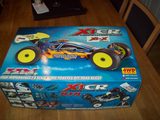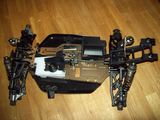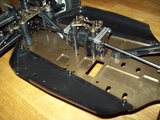Xen on Debian Wheezy (with VLAN networking and LVM storage).
TODO: Add an introduction paragraph, or ingress (so having READ MORE makes sense...)
Preparing the operating system
The absolutely first step in getting a Xen capable Debian Wheezy server, is to install Debian Wheezy. Really, there are no special tricks to this “step”, simply install a base system to your liking. I would reccomend NOT installing any X/Desktop environment at all; keep your Xen server a text-based system. Remember to install SSH server, as you'll probably be remote-managing the system. I'll also suggest you install NTP, VIM and Screen as part of the base install. After completing debian-installer:
apt-get install ntp vim screen
The rest of this prep-section is specific to my setup, you may skip down to “Installing Xen” if you like. In my setup, I'm using two RAID sets, one hardware-array with RAID1 for my root filestystem, and one software-array with RAID5, used as a physical volume for LVM. To set up these, the following packages are needed:
apt-get install mdadm lvm2
Next, to create my sfotware-RAID, I used (after a lot of testing to get acceptable IOPS from the disks):
mdadm --create /dev/md0 \
--verbose \
--level=5 \
--chunk=256 \
--raid-devices=4 /dev/sd{a,b,c,d}
That creates my /dev/md0, as I said, I'm using that as a PV for LVM:
pvcreate /dev/md0 vgcreate sraid5 /dev/md0
Installing Xen
Networking with VLANs on Debian Wheezy
This is a short note on using tagged VLANs on Debian Wheezy. Setting up and using VLANs on Wheezy is slightly changed from previous versions. The most notable difference is that vconfig is finally deprecated also for Debian, and that the “vlan-raw-device” stanza is gone from configuration.
In this short document, I assume that you know how to set up VLAN trunking and -tagging on the network-equipment that your Debian-box is connected to.
Bacula backup server on Debian Lenny, with remote SQL server
This node is a REALLY REALLY incomplete scratch-space for my bacula-related node…
What is Bacula?
First of all, if you are reading this, I hope you have at least a minimal knowledge of what Bacula is. As in, at leas you know that is is a system for backup, recovery and verification of computer data. Hopefully, you also know that it is a scalable, enterprise-ready solution, and you are prepared for that.
As with everything else that gets labeled 'enterprise', and even 'scalable', Bacula is a system that is split into several parts, and is highly configurable. This gives great flexibility, at the cost of being rather complex to set up compared to smaller, simpler systems.
If you are looking to back up your workstation, and only that, bacula is probably not for you. The same is probably true if you are looking at doing backups for a small set of computers; say two-to-four. On the other hand, if you are planning on doing backups for a greater number of systems, across operating systems, and/or require dependable backup volume control, bacula is probably very well suited.
If you are coming from a commercial Enterprise backup solution, you may be surprised (hopefully pleasantly) to see that setup of Schedules, Clients, Jobs and the like are done in text-based configuration files, rather than a point-and-click GUI (or cryptic command line console).
Microcontroller concepts
Microcontroller concepts
Tiny computers surround your life. In your coffee maker, remote control, vacuum cleaner, telephone, and clock radio. Unlike your personal computer, where a central processor has a huge amount of processing power, these tiny computers are special purpose devices that have relative low performance requirements. These tiny computers are, in general, microcontrollers.
Microcontrollers are getting more and more available to the general hobby-hacker through the advent of devices like the BasicStamp and the Arduino.
OFNA/Hong Nor X1X-CR to X1X-CRE (Brushless conversion)
My first step into 1/8 scale offroad racing is a Hong Nor X1X-CR 1/8 buggy, arriving as a nitro car destined for conversion to brushless electric drive.
Electric has become a “standard” for my cars, and brushless my standard for offroad. So the buggy will be no worse that my other cars, and is given a brushless conversion. The -E extension of the model-name reflects my electrification 😛
The X1X-CR is a factory-made options-upgrade of Hong Nor X1-CR RTR. The X1-CR RTR is a “parts-downgrade” of what Hong Nor calls X1-CR Pro, this kit is available under a more familiar name as OFNA Jammin X1-CR. The kit I am based on is a “80% RTR” kit, meaning no engine or electronics are included.So the start of brushless conversion was as simple as removing only a handful of parts.




Debian Lenny based PXE boot setup
In this document I will document my base PXE boot-server setup. It is my intention to have quite a few “features” in my setup, including:
-
Menu-based selection of boot options
-
Booting of installers for several open-source operating systems
-
Booting of Live-environments for several open-source OS.
-
A selection of system-tools, like disk-shredder, partitioning tools, disk-backup and antivirus
-
Support for chainloading other net-boot mechanisms.
The setup is built on Debial Lenny, and is based on pxelinux, a part of the syslinux tools. In general, PXE-booting will be useful for booting x86/ia32-related hardware. Details related to making individual operating systems and distributions PXE bootable are left to separate articles.
Creating a Read only Debian Lenny system
The task here is: at work, we have these cute little Vesa-mount-sized computers originally manufactured by DMP Electronics as the eBOX 4310, rebranded as NorhTec MicroClient Sr, that we are going to use backpack-mounted on large-screen HDTV's for our internal digital signage project.
These little boxes are to have no spinning disk, and an as reliable as possible system. To get no moving parts, the boxes skip using a hard drive, and we are setting them up with Compact Flash (CF) as the main storage. But, as any documentation will tell you, CF has a limited number of write-cycles, and as a result of that, it is desirable to have the system running with its filesystem read-only once booted.
Internally we normally standardize on CentOS for servers, and Ubuntu+Fedora as supported desktop Linux'es. But none of these are really “dead simple” to make read-only-rootfs, and to be honest comes with too much bloat in my opinion. So I am trying to do this using Debian Lenny. Debian is stock, standard, known tech, easily modified (ref. Pebble, LEAF, DSL, Ubuntu, Mint), and supportable. The base install is also fairly easy to make small.
Installing Debian Lenny on the Cobalt RaQ4/RaQ550
My preferred method for installing Debian (or any compatible OS really) onto the RaQ, is the "out-of-body" installation. This requires an i386 - i586 (fairly old) PC with IDE/ATA available as a boot controller. There is quite a bit of "post install cleanup" to do compared to a standard Debian install, so read on...
Debian Kernel compilation and installation for Sun/Cobalt RaQ
Compiling and installing a new, working Linux kernel on a RaQ appliance is not as trivial as it would be on a commodity PC/server. Here, I go through how I got my Lenny based RaQ's up and running with new kernels, starting from an already operational Debian Lenny i386 install